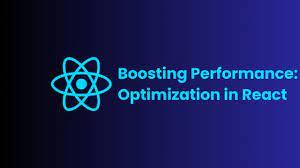In the ever-evolving digital landscape, where the speed and efficiency of a website can make or break user experience, web developers are constantly seeking ways to enhance performance. One of the most popular JavaScript libraries, ReactJS, is widely used for building interactive user interfaces. However, without proper optimization, ReactJS applications can become sluggish, leading to dissatisfied users and high bounce rates. This article delves into the realm of ReactJS optimization techniques, exploring strategies that can significantly boost website performance.
Understanding ReactJS Basics
Before we embark on the journey of optimization, it’s essential to grasp the fundamentals of ReactJS. Understanding concepts like components, states, and props is crucial for implementing effective optimization strategies.
1. Code Splitting for Faster Loading
Large React applications often consist of numerous components, leading to hefty JavaScript files. Implementing code splitting allows developers to split the code into smaller chunks. When users access a specific part of the website, only the necessary code is loaded, significantly reducing initial loading times.
2. Virtual DOM Utilization
ReactJS utilizes a Virtual DOM, a lightweight copy of the actual DOM. By making changes to this virtual representation instead of the real DOM, React minimizes the number of updates, leading to faster rendering and a more responsive user interface.
3. Optimizing Images and Media
Images and media files are notorious for slowing down websites. Utilize image compression techniques and lazy loading to ensure that media files are only loaded when they are visible to the user, preventing unnecessary strain on the website’s resources.
4. Minification and Bundling
Minification involves removing unnecessary characters and whitespace from code, reducing file sizes. Bundling, on the other hand, combines multiple files into a single file, reducing the number of requests made to the server. Together, these techniques optimize the loading speed of React applications.
5. Efficient State Management
Careful management of state in React applications is crucial. Implement libraries like Redux for centralized state management. By efficiently managing state, unnecessary re-renders can be avoided, leading to a more responsive user interface.
6. Server-Side Rendering
Implementing server-side rendering (SSR) ensures that a pre-rendered page is sent to the client instead of an empty HTML file. SSR significantly improves the time to first paint, enhancing the perceived performance of the website.
7. Mobile Optimization
In the mobile-first era, optimizing React applications for mobile devices is paramount. Utilize responsive design principles and media queries to ensure that the website performs seamlessly across various screen sizes and devices.
8. Regular Performance Audits
Regularly auditing the performance of a ReactJS application is essential. Utilize tools like Lighthouse and Google PageSpeed Insights to identify bottlenecks and areas for improvement. Performance optimization is an ongoing process, and continuous audits are key to maintaining a high-performing website.
Conclusion
Optimizing website performance is crucial for user satisfaction and business success. By implementing advanced ReactJS optimization techniques, such as code splitting, lazy loading, and minimizing bundle size, websites can load faster and provide seamless user experiences. To achieve these enhancements, businesses should consider hiring skilled ReactJS developers who possess expertise in these optimization strategies. By investing in talent, companies can ensure their websites not only meet user expectations but also outperform competitors, ultimately leading to higher engagement, conversions, and overall success in the digital landscape. Hire ReactJS developers today and elevate your website’s performance to new heights.
FAQs
Q1: Why is ReactJS optimization important for websites? Optimizing ReactJS ensures faster loading times, better user experience, and higher engagement, leading to increased satisfaction and retention.
Q2: How does code splitting enhance website performance? Code splitting reduces initial loading times by loading only the necessary code chunks, improving the overall speed of the website.
Q3: What role does server-side rendering play in ReactJS optimization? Server-side rendering pre-renders pages and sends them to the client, improving the time to first paint and enhancing perceived performance.
Q4: Is it necessary to perform regular performance audits for ReactJS applications? Yes, regular performance audits using tools like Lighthouse and Google PageSpeed Insights help identify bottlenecks and areas for improvement, ensuring ongoing optimization.
Q5: How can developers implement responsive design principles in ReactJS applications? Developers can utilize media queries and responsive design techniques to ensure that ReactJS applications adapt seamlessly to various screen sizes and devices.




